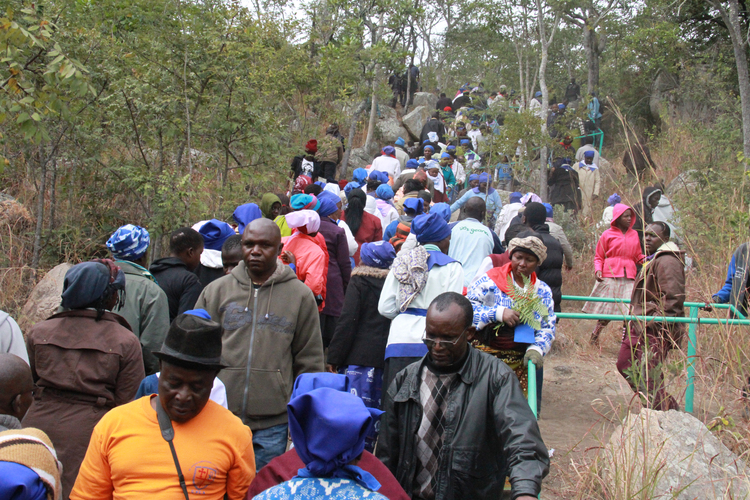
The Sunday Mail


Thousands of pilgrims retrace the route walked by Anglican martyr Benard Mizeki last week in Marondera (Inset) Bishop Chad Gandiya
Thousands of members of the Anglican Church of the Province of Central Africa (CPCA) converged at the Benard Mizeki shrine in Marondera for their annual conference last Friday.
The three day conference was in memory of Benard Mizeki, an Anglican catechist and martyr who died on June 18, 1896. Pilgrims, including non-Anglicans from beyond the country’s borders travel each year to gather in remembrance of Mizeki.
The three days are dedicated to mass services, music and dance, prayers and a guided tour to the top of the mountain where Mizeki is believed to have disappeared from. Canon Wisdom Changoza, who is the Benard Mizeki chaplain, said between 15 000 to 20 000 people converge for the conference every year.
Even during the close to five years dark period when the Anglicans were barred from accessing the shrine at the peak of the conflicts with former Bishop Nolbert Kunonga, they made attempts to visit the shrine. One of the things that amaze the chaplain is that he has never seen a fly at the shrine ever since he assumed his position way back in 1988. That seemingly simple fact probably endorses the holiness of the place.

Bishop Chad Gandiya
However, it boggles the mind how Mizeki, even from his grave, still manages to consistently draw so many people.
Could it be because he opted to stay when missionary workers were being ordered to safety at the height of a revolt against colonialism?
The CPCA’s theme for this year is “Call to Discipleship” and it resonates with Mizeki’s life. Leader of Anglican Church of the Province of Central Africa (CPCA), Bishop Chad Gandiya said the commemorations remind Anglicans of their need to remain committed during bad or good circumstances.
“Benard Mizeki left a good example for Christians across the board of what it means to be committed, not only when things are going on well but in good and bad times.
In some manner, most Anglicans remained true disciples during the conflicts with former Bishop Kunonga. They continued to believe justice would prevail despite the conflicts that were threatening to tear the church apart.
“I am the luckiest bishop, l lead a committed people. These people didn’t desert us knowing what we went through. Some were beaten, some were disgraced but they remained resolute.
“However with the passage of time people tend to relax. So that’s why this place is important because we are reminded to renew our faith and be rejuvenated,” Bishop Gandiya said.
At the shrine, there is a pond where Mizeki is believed to have washed his wound after being stabbed during an attack by villagers who had begun a rebellion against the British.
According to Canon Changoza, people believe the water from that pond has healing powers. The pool never dries.
“It is said when he got to the pond, he instructed his wife to go back to the village and prepare him some porridge. However, out of fear that his attackers would pursue him, Mizeki began crawling up the mountain for close to 300m.
“ As we climb up that mountain we remember his blood. Some believe if you drink water from the pond you will be healed,” Canon Changoza said.
At the peak of the shrine, there are fenced balancing rocks. It is believed that when Mizeki got to this place, he disappeared.
“lt is believed that one of those stones split after being hit by lightning and that is when his body disappeared. Some say he was taken to heaven while others say his body was stolen by people,” he narrated.
People who visit the shrine recline on the fence in prayer.
While some wail, others throw money notes as a seal of their petitions to God.
Born in Mozambique, Benard Mizeki travelled to South Africa in search of employment. He met Bishop George Knight- Bruce and in 1891, they both came to Zimbabwe and settled among the Nhowe people under Chief Mangwende.
According to historical sources, in 1896 the Ndebele people rebelled against the British South Africa Company and in March that year, the Matabeleland Rebellion spread into the Shona regions.
During the time, southern Africa had been experiencing drought and locust plagues, which led to famine and animal diseases. There were orders to kill and burn infected cattle. The African tradition realises cattle as a symbol of wealth and therefore these moves did not go down well with the indigenous people.
Resentment against the British, their taxes and mandatory inoculations simmered. As a result, missionary workers were ordered to vacate the area and go to safety. Mizeki refused to leave.
“At that time Christianity was seen as a white man’s religion. Mizeki was viewed as a white front man. His resistance to let go of what he believed in led to his demise.
“We celebrate him because he became a martyr. After Mizeki was murdered, Moleli was also killed in the Chihota area within a week,” Canon Changoza added.
During the annual conference, Anglicans conduct a communion service.
“This place is also used as a retreat when people want to pray on any other day. Spiritually, it is a life changing place. People seek God in this place and it’s a unifier. It’s a place to relax mentally and fellowship,” highlighted Canon Changoza.
A boys’ college was built and named after Benard Mizeki in his honor. Canon Changoza said God willing, a university will be built soon.



